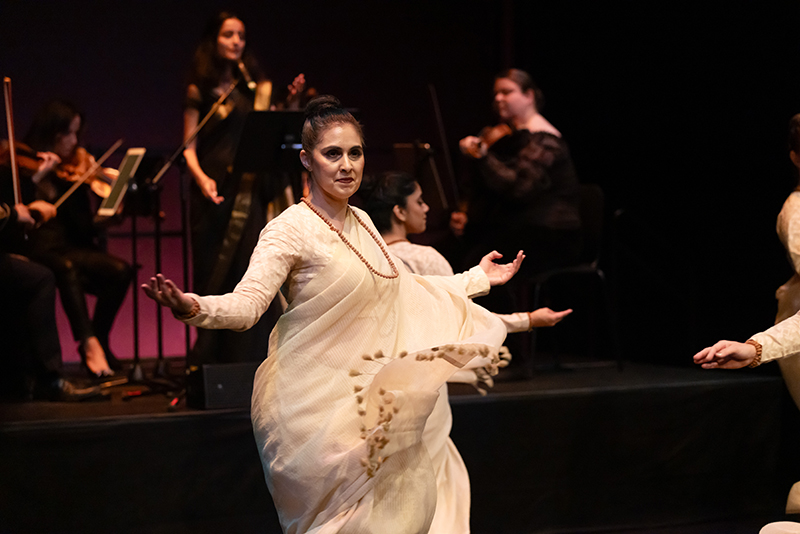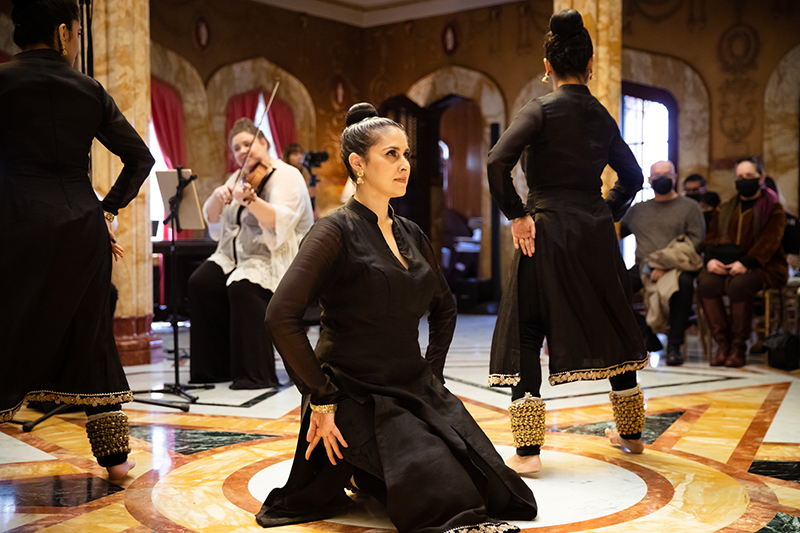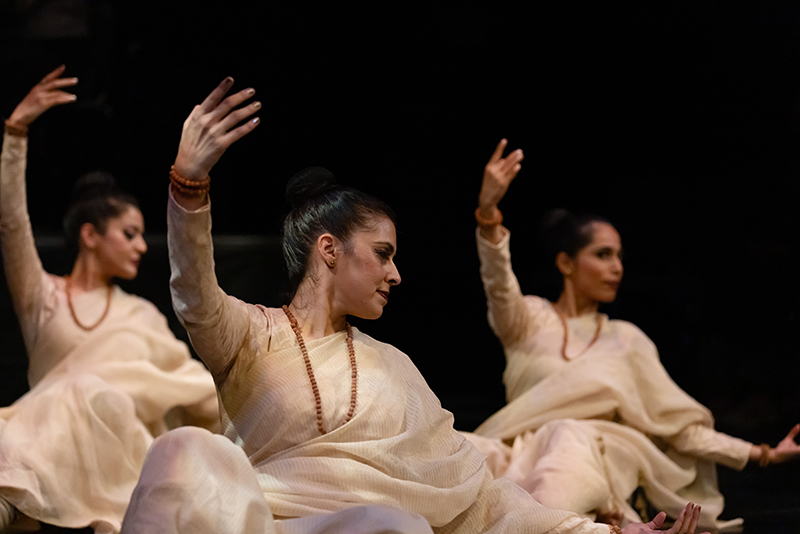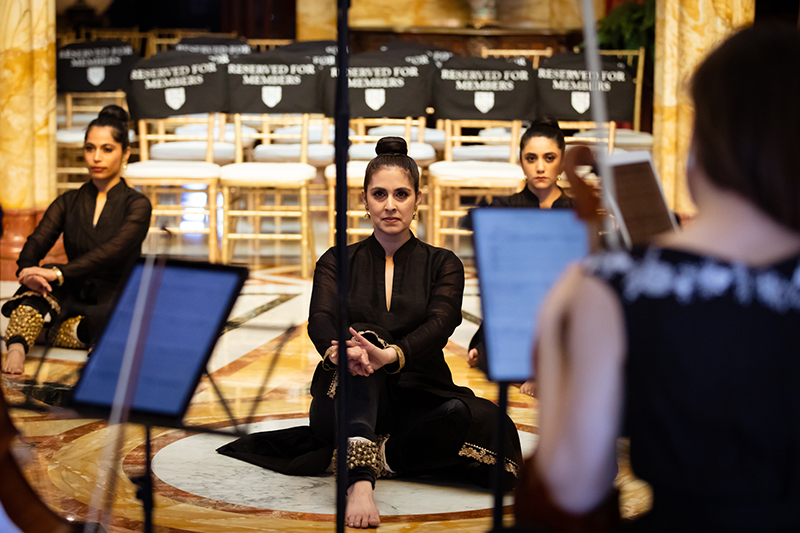Building A Future for Kathak Dance
An Interview with Rukhmani Mehta about The Leela Foundation
BY EMMALY WIEDERHOLT
Photos by Margo Moritz
Rukhmani Mehta is a cofounder and co-artistic director of Leela Dance Collective. Based in Los Angeles, the collective promotes kathak dance and Hindustani music through traditional performance and cross-genre collaboration. In addition to the collective, Rukhmani instigated The Leela Foundation to promote the viability of kathak dance and Hindustani music in the US, which recently reached its initial $1 million funding goal. Rukhmani shares how she hopes to help support a viable kathak and Hindustani music scene in the US for years to come.

~~
How did Leela Dance Collective get started and what was the goal or mission when it was founded?
The story of the collective begins with my teacher, Pandit Chitresh Das, and his work to establish kathak dance on the world stage and bring the West into the world of kathak dance. He was a pioneer; he came to the US in the early 70s. I studied with him in the traditional mode and danced in his company for many years. I was one of many dancers in his company. In 2015 he passed away quite suddenly. As we considered our artistic futures, a few of his disciples and senior students got together to figure out how we could carry forward what we inherited of his legacy. A series of conversations led to us forming Leela Dance Collective.
We believed in working together. Typical dance companies are led by a single artistic voice and vision. We felt strongly that we needed a space not only for individual visions but also a space to exchange ideas and work collaboratively. That’s the reason it became a collective, with shared leadership.
That was in 2016. The collective began as an experiment. Collectives are not common, and collaborations can be messy. Our work together is always evolving, but it’s been a phenomenal experience. Every time we do an artistic work, we continue to get validation. I direct the collective with two fellow artists: Seibi Lee and Rachna Nivas. We were raised together in the form, and we bring unique perspectives and artistic sensibilities to the work.
Since Leela Dance Collective was founded, we’ve created a couple artistic works that have toured. SPEAK is a collaboration with musicians and tap artists Michelle Dorrance and Dormeshia. Collaboration across genres is central to our artistic process. That piece has traveled around the country and to India. Another piece was a traditional dance drama, Son of the Wind, based on the Indian epic Ramayana. It has also toured around the country and India.
Currently we’re working with a string quartet in Los Angeles, Salastina, bringing classical kathak and Hindustani in conversation with Western contemporary music. Collaboration is an important part of what we do, in addition to making spaces for the tradition in its true form and shape, like our production Son of the Wind. Our work is how we push the form forward, expand its possibilities, have conversation with other artforms, but also create spaces to shine a light on the form in its original intent.

Finally, our work is about elevating the voices of women choreographers and artists. Our teacher was a male dancer, and all his senior disciples were women. When he passed away, not only was there this generational transfer, but there was also this big gender shift. We want to make that shift explicit.
I understand that also in 2016, Leela launched a campaign to establish The Leela Foundation, the first United States-based endowment for North Indian artistic and cultural heritage. Why was it important to establish a foundation beyond the work you were doing with Leela Dance Collective?
In kathak dance specifically, there are very few opportunities for dancers and musicians to pursue their career full-time. The financial infrastructure does not exist. With the creation of our company and The Leela Foundation, we want to change this issue.
Before founding Leela Dance Collective, I’d been in the dance world for nearly 20 years, and was involved in fundraising. I learned about the challenges that a dance company faces and felt many limitations for our art form were financial. Depending solely on foundation support is difficult: funders can shift their priorities (we have seen this in LA in recent years) and in the US, funders perspectives are often grounded in Western notions of artistry. Most funding in our field is for new work, and that can be difficult for companies that are torch bearers for classical or traditional forms. We are always showing how preserving the integrity of our kathak art form does not mean that the form is static.
All of this is to say that while grant funding remains important for our company, it is also important to pursue individual donations, major gifts, and other forms of contributed income in order to thrive artistically. The creation of an endowment is one path to more secure funding, and a stronger financial future.
Most people told me not to try to raise an endowment. We are a young company and most nonprofit organizations do not pursue an endowment until they have a large operating budget. But I felt strongly we needed a better financial floor for the form, and that we could inspire supporters.

This past fall you reached your initial $1 million goal for The Leela Foundation. What are your goals with this funding?
For us, the main thing we’d like to do with the funding as it grows is support dance artists and musicians. That means direct salary support for artists who work contractually. The other way is to create residencies and fellowships for artists to work with fellow dancers or musicians they wouldn’t usually be able to. That also provides a platform that can be educational and/or performative to promote their work.
Why is it important to create infrastructure for kathak dance and Hindustani classical music in the United States?
The lack of infrastructure is a direct result of colonialism in India. The colonial legacy remains strong; there was a loss of artistic heritage during that time. In the late 1800s, dance was publicly banned. A lot of dance educators lost their livelihoods. The current severe lack of infrastructure is a result of colonialism and a function of the fact that independent India is still young. Philanthropy and patronage in the foundation community is young in the South Asian community.
And yet, you can still trace back dance lineages. Despite that lack of support, there are a lot of teachers who have done great work to pass on the tradition. We’re at a unique moment in history when an endowment is possible. It would have been less possible 30 to 40 years ago when the South Asian immigrant community in the US was new. Indian culture and art have become vibrant and alive in the US, from yoga to Indian food. The world has opened to Indian culture and art. And the South Asian community has started to become more established and philanthropic. In the 70s when my teacher came here, there were many Indian classical artists who made their homes in California. They have taught many students and have thus passed the art form on to Americans of all different backgrounds. There’s a large artist community that’s playing an important part in carrying forward the legacy.
What does it mean to you for an art form that was developed in Northern India to grow and flourish in the US?
In so many ways, it’s been an amazing journey to practice and perform this art form in the US because I am in a diverse community. I must reflect: What does it mean to be Indian? What exactly is kathak? It’s been a gift to do that work of translating the traditions for diverse audiences. For me, that work has added a level of rigorous critical thinking about what is kathak dance, its history, and its intent. When I’m performing for audiences who don’t have the same cultural background, I must communicate clearly about my form and help make it accessible and relevant.

What’s your vision for The Leela Foundation and more generally for kathak dance in the US for the years to come?
When I talk to my donors about the foundation, I tell them that if you look at any major city in the US, it’ll have a symphony, a ballet, and an opera. There’s diversity of artistic expression; there are many symphonies and ballets, and they are supported by strong patronage and are valued by many donors. That’s my dream for kathak and Hindustani classical music. I was a typical south Asian immigrant kid. I studied the sciences and math and was supposed to be a doctor or lawyer. When I decided to be a dancer, people asked how I would support myself financially. I said I would get married, and my husband would support me. It’s funny now, but that seemed like my only option. Back then, I couldn’t train in kathak and then audition for companies and make a living. We are striving to change the future for kathak artists. My dream is for there to be kathak schools and companies in abundance and jobs for artists so that they can see a future for themselves and make a living doing this work, and that the art form is thriving.
~~
To learn more about Leela Dance Collective and The Leela Foundation, visit leela.dance.
